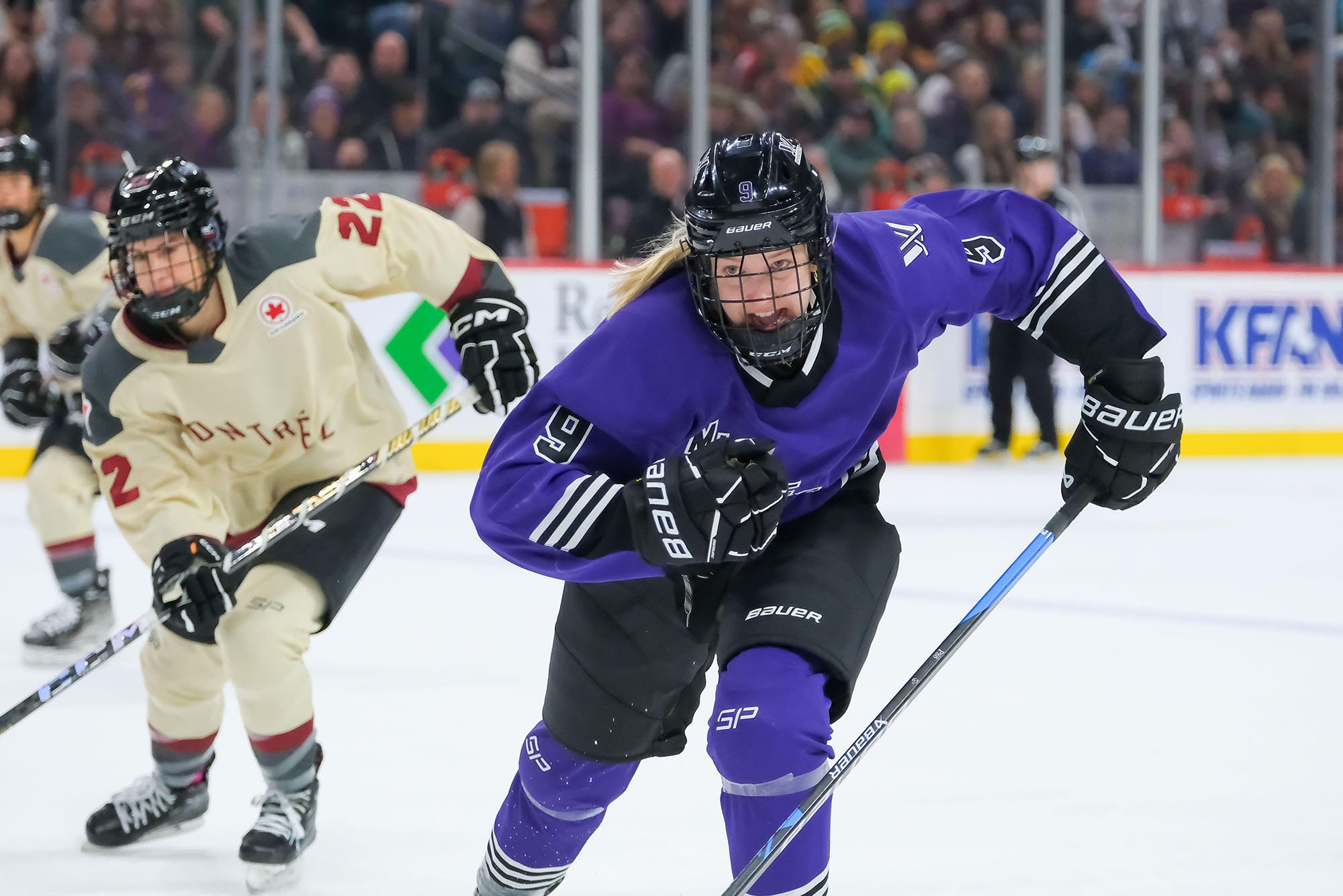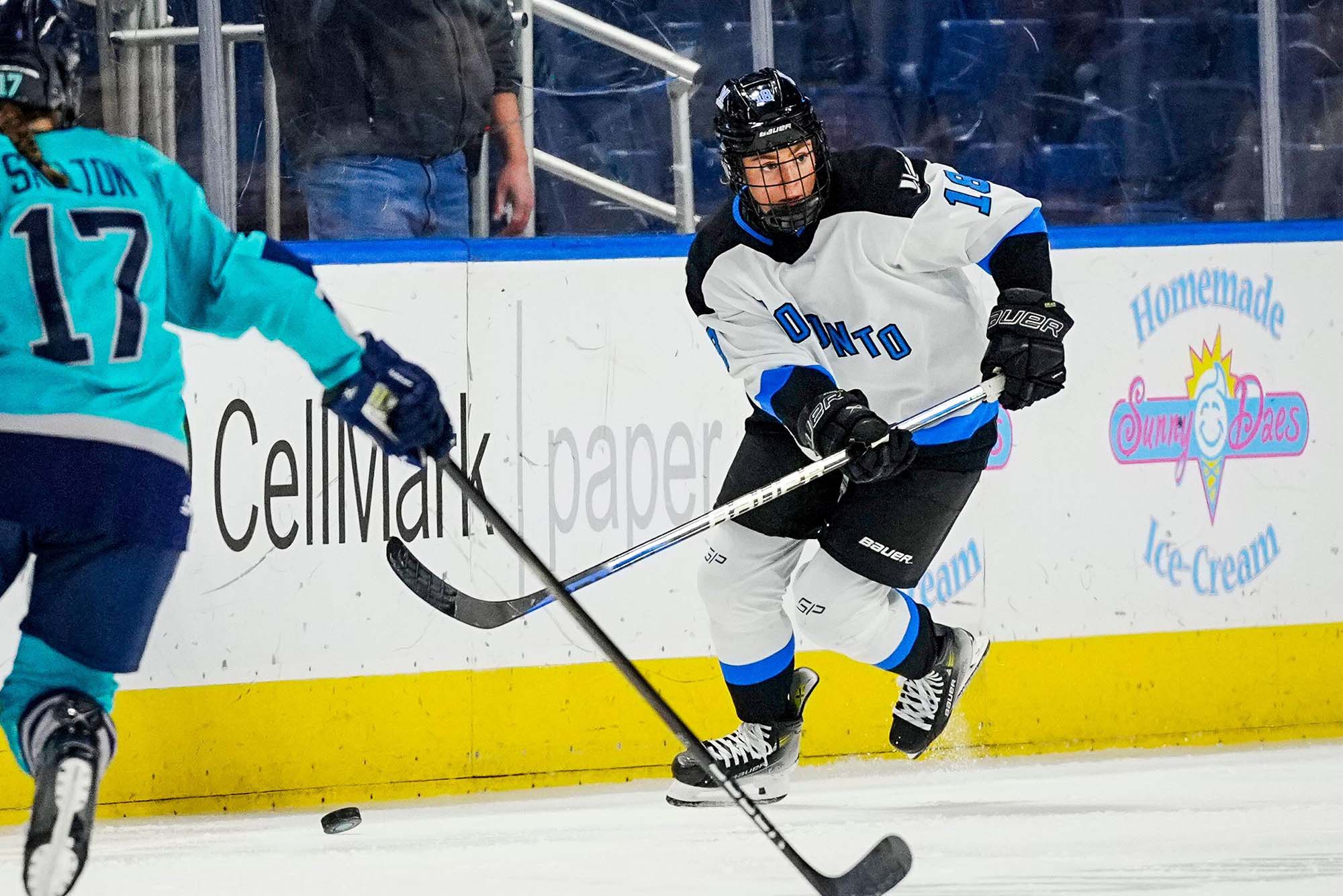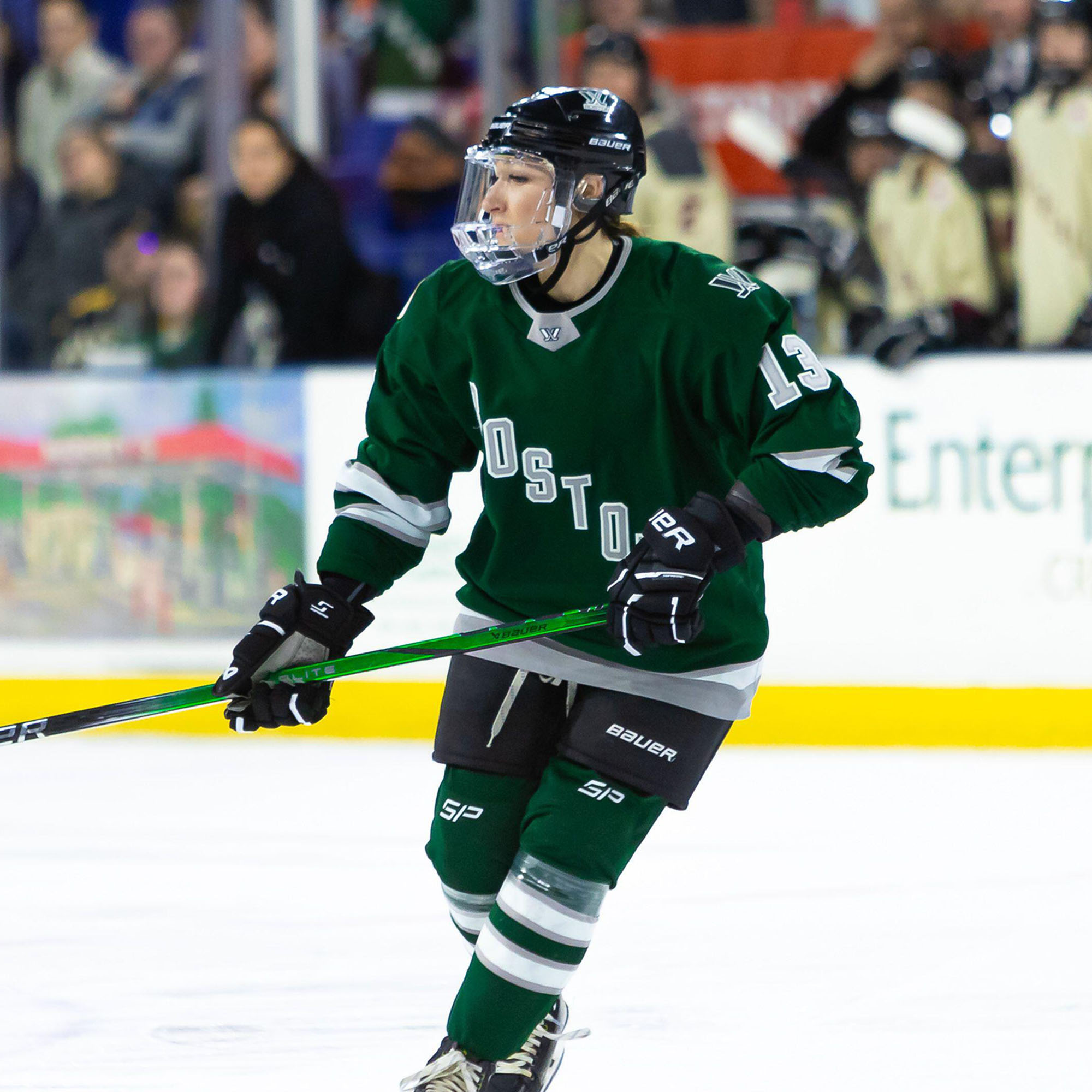Former Terriers Power New Professional Women’s Hockey League

Toronto forward Rebecca Leslie (Questrom’18) (right) takes a shot past New York forward Paetyn Levis during a Professional Women’s Hockey League game in Bridgeport, Conn. Photo by Rusty Jones/Cal Sport Media/Alamy Live News
Former Terriers Power New Professional Women’s Hockey League
It’s not only fulfilling lifelong dreams, the league is also breaking attendance records and drawing large television audiences
Standing alongside her Toronto teammates at Scotiabank Arena before a record-shattering crowd on February 16, Rebecca Leslie realized professional women’s hockey had arrived.
As a Canadian, born and raised in Ottawa, Boston University’s former captain was well-versed in the storied hockey rivalry between Toronto and Montreal. Although the rivalry was forged by men, that night’s “Battle on Bay Street” featured Leslie’s Toronto team against Montreal in a marquee game for the new Professional Women’s Hockey League (PWHL).
Earlier, their coach had tried to prepare them for the historic moment at the Maple Leafs home rink. “You’ve never played in front of this many people,” he told them. “Give yourself a moment to take it in.”

Leslie did. All around her, 19,285 fans—more than had ever attended a women’s hockey game anywhere in the world—showered them with applause. The swarm of faces made it harder for her to pick out her parents, part of her pregame ritual. She saw young girls ringing the rink, pressing signs they’d made against the glass for the players to read. Hearing the familiar strains of “O Canada,” her national anthem, and tracking a giant Canadian flag passed by fans through the stands overwhelmed her. “I got chills,” says Leslie (Questrom’18).
As a young girl herself in the 2000s, while her older brother aspired to play in the NHL, Leslie dreamed—like many girls playing hockey in North America—of playing Division I hockey. And maybe, one day, for the national team in the Olympics.
There have been several other women’s hockey leagues in the past 15 years, but none with the potential for long-term sustainability like the PWHL. The new league, which began play January 1, 2024, is breaking attendance records and drawing large television audiences. Most significantly, the PWHL is giving Leslie and fellow former Terriers—nine this season—the chance to make hockey a career choice after college and reshaping the dream for young girls. A new league provides not only playing opportunities, but also coaching jobs, front office positions, and league administrative jobs.
Former BU players have made key contributions to the league’s early success. Leslie was one of five former Terriers playing in the historic game at Scotiabank Arena in February. Her Toronto teammates—Jesse Compher (CGS’19, SHA’21), BU captain in 2020–2021, and Victoria Bach (CGS’16, COM’18), BU’s all-time leading scorer—both scored in their 3-0 win that night. Marie-Philip Poulin (CAS’15), who captained the Terriers her final two seasons, and Sarah Lefort (CGS’14, Sargent’16) play for Montreal. Abby Cook (CGS’18, Sargent’20) and Kaleigh Fratkin (CGS’12, COM’14) play for Boston, and Sammy Davis (CGS’17, Sargent’19, Wheelock’20), another former two-year Terrier captain, who had been a reserve for the Boston team, signed with Ottawa in this month. Corinne Schroeder (Sargent’21, CAS’21) plays goalie for the New York team.

Alexis Miller (CAS’16, MET’17) is one of several BU alums in PWHL supporting roles. Others include Daria Iglow (CGS’07, Questrom’09), the New York team’s director of operations, and Kanan Bhatt-Shah (COM’06), the PWHL’s brand and growth marketing leader.
The PWHL seems poised to succeed where its predecessors have failed. The Canadian Women’s Hockey League (CWHL) was founded in 2007 as an amateur association with no salaries. Players had to buy their own gear. A rival league, the National Women’s Hockey League (NWHL), began play with four teams in 2015 and paid player salaries ranging from $10,000 to $26,0000, luring some athletes from the CWHL. A brief infusion of money from Chinese investors allowed the CWHL to pay stipends up to $10,000 in the 2018–19 season, but the league folded afterward. The NWHL was beset by its own financial difficulties and a lack of transparency. As a result, in 2019 more than 200 players formed the Professional Women’s Hockey Players Association (PWHPA), which played a series of exhibition games over the next several years. They announced a boycott of the NWHL “until we get the resources that professional hockey demands and deserves.”

That came to pass when Los Angeles Dodgers’ owner Mark Walter, whose net worth Forbes estimates to be $5.8 billion, committed to backing the new Professional Women’s Hockey League and signed on to an eight-year collective bargaining agreement. Walter brings not only the necessary financial backing, but also the sports ownership savvy lacking in previous professional women’s hockey ventures. In addition to the Dodgers, he has an ownership stake in the Los Angeles Lakers, the Los Angeles Sparks, and the Chelsea Football Club.
Hiring more than 100 employees for the PWHL and its six teams, Walter has provided the staff with the money and know-how it needs to market and run the league. Once the PWHL announced its formation last summer, the NWHL, which had rebranded itself the Premier Hockey Federation, ceased operations. Its players and those from the PWHPA filled the rosters of the PWHL’s six new teams.
The league scrambled to begin play on January 1, 2024. It is committed to start earlier next season and expand the schedule from 24 to 32 regular-season games. There are also plans to add team names and mascots. At present, the teams are identified simply by their host cities or state: Toronto, Montreal, Ottawa, Boston, New York, and Minnesota.
Player salaries in the new league range from $35,000 to $80,000 this first year and are expected to rise annually during the eight-year collective bargaining agreement. There are also stipends paid for housing, moving, and even for nannies traveling to away games with the children of the handful of mothers playing in the PWHL.

“We want to set a precedent for support,” says Miller, senior director of player experience for the PWHL, who captained the Terrier women’s ice hockey team in 2016–17. “It used to be going pro was like taking 10 steps back. In college they had equipment, and medical and staffing support. For the first time ever, players are walking out of college with the same support. We’re hoping that becomes the expectation, not the exception.”
The support comes in the form of everything from laces and tape to staff who sharpen skates and cut sticks to length. It also includes medical personnel who can diagnose injuries and help players recover from conditions that in the past might have cut short a career. While these services were provided at the college level, they were not a given for those who played afterward. Often players had to schlep their gear to and from the rink, find other locations to train, and seek independent medical treatment.

“We weren’t really set up to be successful,” says Fratkin, who played a year in the CWHL and eight in the NWHL. She now plays with the PWHL’s Boston team, which has its facilities at the Boston Sports Institute in Wellesley, Mass., complete with a gym, dedicated locker room, and trainer services. “It’s great to have everything in one place,” she says.
With past leagues, players had to work another job to supplement their hockey income. The PWHL’s salaries—closer to a livable wage—and the wraparound support give them the chance to make hockey a career after college, rather than a side job.
“There’s an opportunity to keep playing beyond your graduation date,” Miller says. “There have been opportunities to play professionally in the past, but now it’s possible to do so as a career because of the salaries and the infrastructure.”
Besides a more promising future, the new league has enjoyed a higher profile than previous professional women’s hockey leagues. The NHL staged a PWHL All-Star game as part of its All-Star Weekend festivities in February and has hosted games in its arenas in Detroit and Pittsburgh, in addition to the game at Scotiabank. (The Minnesota team plays its home games in the Wild’s arena, the Xcel Energy Center.) Games are broadcast more widely on television. The hockey equipment company Bauer has aired a couple of heartstring-tugging commercials with the taglines, “Girls deserve equal ice” and “Everything for the girls.”
All of this is expected to grow the game among girls and provide stability for options to keep playing, much like the National Women’s Soccer League has done for soccer.
“Unfortunately, when I was growing up, [professional women’s hockey] wasn’t even a reality,” Fratkin says. “The PWHL is going to change the trajectory of the game. Girls are going to get into it younger and in more numbers. It’s opening the door to a reality for these young girls I never had.”
The PWHL aims to give young girls role models they can watch in person and on television and provide a place for them to imagine playing beyond college or the Olympics.
The significance of those advances for female athletes is not lost on someone like Leslie, who grew up playing with boys and having to change in closets. “To see that the girls I coach or even my own kids one day can have the goal to play professionally is pretty special,” she says.
Comments & Discussion
Boston University moderates comments to facilitate an informed, substantive, civil conversation. Abusive, profane, self-promotional, misleading, incoherent or off-topic comments will be rejected. Moderators are staffed during regular business hours (EST) and can only accept comments written in English. Statistics or facts must include a citation or a link to the citation.